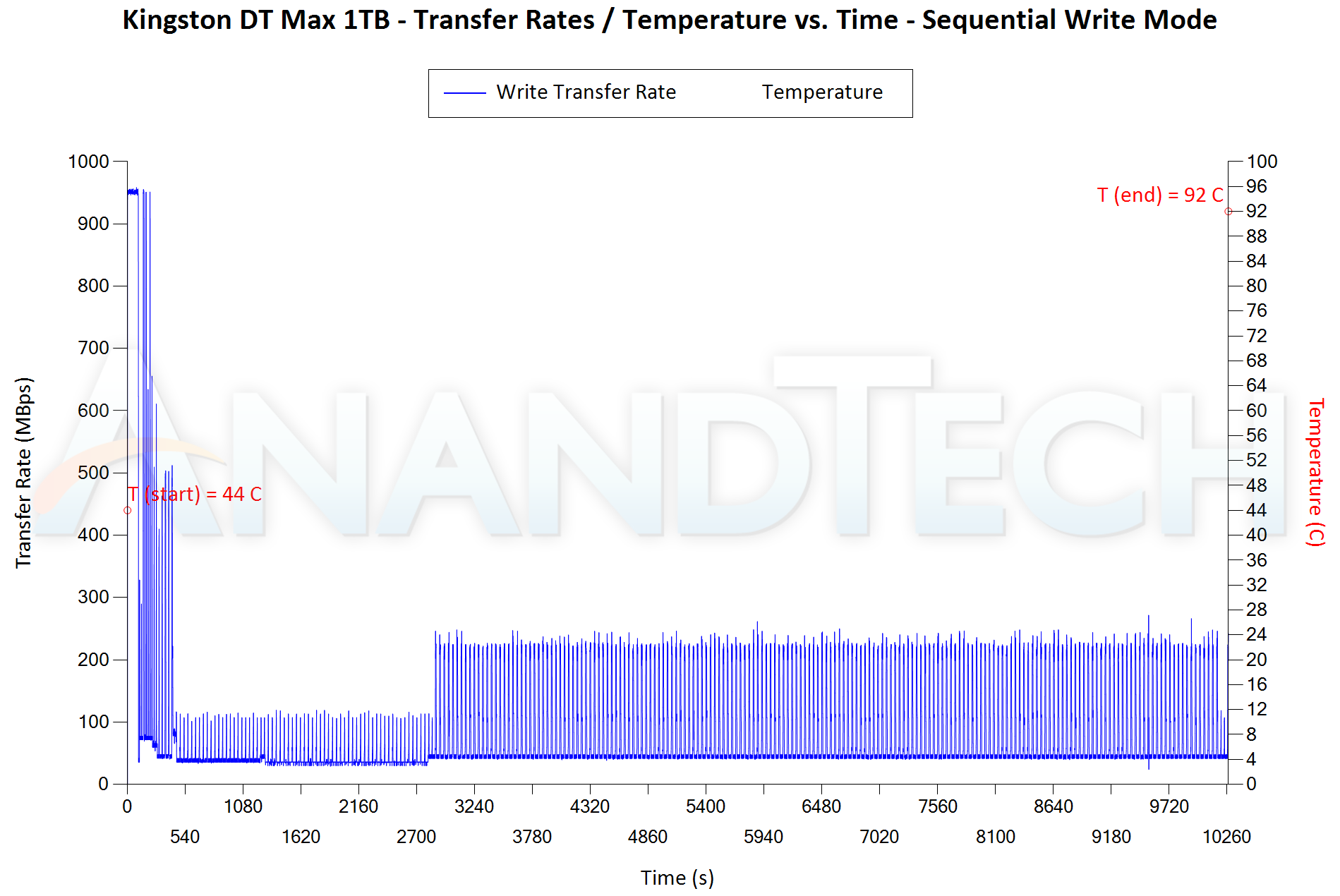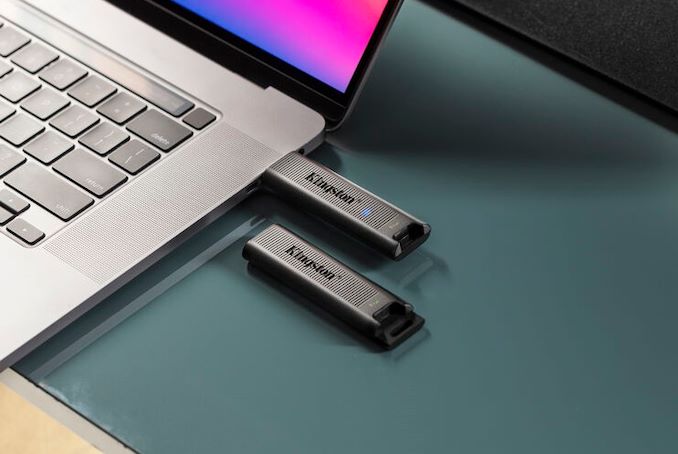Kingston DataTraveler Max UFD Review: NVMe Performance in a USB Thumb Drive
by Ganesh T S on September 30, 2021 10:00 AM ESTMiscellaneous Aspects and Concluding Remarks
The performance of the Kingston DT Max in various real-world access traces as well as synthetic workloads was brought out in the previous section. We also looked at the performance consistency for these cases. Power users may also be interested in performance consistency under worst-case conditions, as well as drive power consumption. The latter is also important when used with battery powered devices such as notebooks and smartphones. Pricing is also an important aspect. We analyze each of these in detail below.
Worst-Case Performance Consistency
Flash-based storage devices tend to slow down in unpredictable ways when subject to a large number of small-sized random writes. Many benchmarks use that scheme to pre-condition devices prior to the actual testing in order to get a worst-case representative number. Fortunately, such workloads are uncommon for direct-attached storage devices, where workloads are largely sequential in nature. Use of SLC caching as well as firmware caps to prevent overheating may cause drop in write speeds when a flash-based DAS device is subject to sustained sequential writes.
Our Sequential Writes Performance Consistency Test configures the device as a raw physical disk (after deleting configured volumes). A fio workload is set up to write sequential data to the raw drive with a block size of 128K and iodepth of 32 to cover 90% of the drive capacity. The internal temperature is recorded at either end of the workload, while the instantaneous write data rate and cumulative total write data amount are recorded at 1-second intervals.
| Sequential Writes to 90% Capacity - Performance Consistency | |
| TOP: | BOTTOM: |
 |
|
 |
|
The Kingston DT Max sustains the maximum write transfer rate for close to 100 seconds - around 95GB of data - before the 'direct-to-TLC' writes start. Beyond that, the write speeds drop down to an average of around 80 MBps. This type of SLC caching behavior / direct-to-TLC penalty is not seen in the dual-chip bridge solutions. It must also be noted that the temperature read-out was 92C at the end of the process. Given the lack of a thermal solution inside the UFD, and the transfer rates involved, it is not much of a surprise to see the high temperature.
Power Consumption
Bus-powered devices can configure themselves to operate within the power delivery constraints of the host port. While Thunderbolt ports are guaranteed to supply up to 15W for client devices, USB 2.0 ports are guaranteed to deliver only 2.5W (500mA @ 5V). In this context, it is interesting to have a fine-grained look at the power consumption profile of the various external drives. Using the Plugable USBC-TKEY, the bus power consumption of the drives was tracked while processing the CrystalDiskMark workloads (separated by 5s intervals). The graphs below plot the instantaneous bus power consumption against time, while singling out the maximum and minimum power consumption numbers.
| CrystalDiskMark Workloads - Power Consumption | |
| TOP: | BOTTOM: |
 |
|
 |
|
While bridge chip-based solutions operate at around 2.5W with peaks of 5W+, the Kingston DT Max is much more power efficient. The UFD goes to deep sleep of around 8 - 9mW after around 20 minutes of lack of traffic. Average power usage is around 1.4W, and the peak is only 3.04W.
Final Words
The Kingston DT Max is available for pre-order today - hovering around $166 on B&H. It appears that retailers are happy to tag on a premium to this product for its uniqueness, given that the 2GBps-capable Kingston XS2000 is priced lower at $160. Given that the 256GB and 512GB versions are priced at $58 and $97, a sub-$150 price for the 1TB Data Traveler Max would work better on the current market. The real competition here is the dual-interface Akasa AK-ENU3M2-04 with its male connectors and user-replaceable SSD. Including a 1TB SSD would still land it at a sub $140 price point.
Overall, the Kingston DataTraveler Max is a hands-down winner in terms of industrial design, form-factor, performance, power efficiency, and uniqueness. The SLC cache is big enough for users to not worry too much about the sub-100 MBps performance numbers seen for extreme workloads. That said, there is some scope for improvement in thermal design. Additionally, a dual-connector (Type-C + Type-A) product could be a great addition to the family. Given what we have seen of Silicon Motion's SM2320 in the Kingston DataTraveler Max, it is clear that USB thumb drives are approaching portable SSDs in performance - that is good from a consumer viewpoint.











12 Comments
View All Comments
cyrusfox - Thursday, September 30, 2021 - link
Nice performance! Too bad about the price premium for the form factor[$180], hard to compete with other flash drives, definitely the performance crown at the smallest size, but easier to get a cheap m.2 enclosure and deal with the extra bulk and equivalent to superior performance, what else to do with the spare m.2 chucked from laptops...eastcoast_pete - Thursday, September 30, 2021 - link
The absence of any "thermal solution" is disappointing for that device and price class. A small strip of a quality thermal pad (FujiPoly or comparable) and it would likely not get that dangerously hot (hot enough to cause mild burns). Well fitted thermal pads, and a body made from cast aluminum (as heat sink), and it'd probably be all set, at least temperature-wise.Actually, what is that case made of? Did I overlook that in the article?
ganeshts - Thursday, September 30, 2021 - link
Casing is fully plastic. In one sense, this may be user-friendly - the exterior doesn't get hot enough to touch (something that is bound to happen a lot for a thumb drive). But, as suggested, the internal board deserves a thermal pad at the least.eastcoast_pete - Thursday, September 30, 2021 - link
Thanks for the update! Given the price point of that drive, another dollar or two in the BOM for an anodized aluminum body (as heatsink) and a few square centimeters of thermal pads would have been a great investment that would have helped sales.Tams80 - Friday, October 1, 2021 - link
It's also supposed to be practically portable though, and plastic is far less likely to cause damage to other items in bags/on key chains and won't look too bad acter some abuse. Aluminium on the other hand is terrible for that and will end up looking a mess.meacupla - Sunday, October 3, 2021 - link
A properly designed partial aluminum enclosure won't damage other things in your bag.Also, if your, be it partial or fully, aluminum enclosure is getting significantly messed up, maybe don't throw it in a bag that also contains your keys.
meacupla - Thursday, September 30, 2021 - link
I half expect someone to make this drive go even faster by adding some thermal pads and a chunky heatsink.I would guess the controller has thermal protection and throttles when it gets hot.
Wereweeb - Friday, October 1, 2021 - link
>Can't transfer more than 90GB of data per time, otherwise falls to QLC speeds>Half the random speeds of NVMe-through-USB
Ok, I get it, first-gen, too compact
>Couldn't find a way to cool down the controller while still making it skin-friendly (Aluminium body with fins, thermal pads, maybe some silicone on the edges for more comfort in handling?)
>$160 for 1TB NAND on a simple PCB in an injection-molded plastic shell.
Is it just me or does this look like a somewhat weird first-gen-y product that doesn't seem to know if it wants to directly compete with NVMe SSD's on performance?
Up2Trix - Sunday, October 3, 2021 - link
Ganesh, thanks much for this review. I am very much in the market for a flash drive of this type. I have been waiting for powerful USB controllers for, I dunno, 6+ years now...I currently own a Corsair Flash Voyager GTX. It uses a SATA SSD controller (crappy low end one?) behind a USB <--> SATA bridge chip. It was about the best flash drive available until this Kingston, but Corsair has stubbornly refused to update it since it was released 3 or 4 years ago.
I would love to upgrade from the Corsair, but nobody was releasing anything compellingly better. This Kingston is a leap forward.
I am with eastcoast_pete: my main dislike of this Kingston is the absence of any "thermal solution", and I too would like its body to be aluminum (even if it scratches).
I too would also love if it had a dual-connector (Type-C + Type-A).
Corsair: I hope that you are reading this!
PleaseNoMoreVideoAds - Sunday, October 3, 2021 - link
I just made an account to say: PLEASE DO SOMETHING ABOUT THE AUTOPLAYING VIDEO ADS WITH AUDIO.The site is becoming unusable.
Thanks and best wishes.